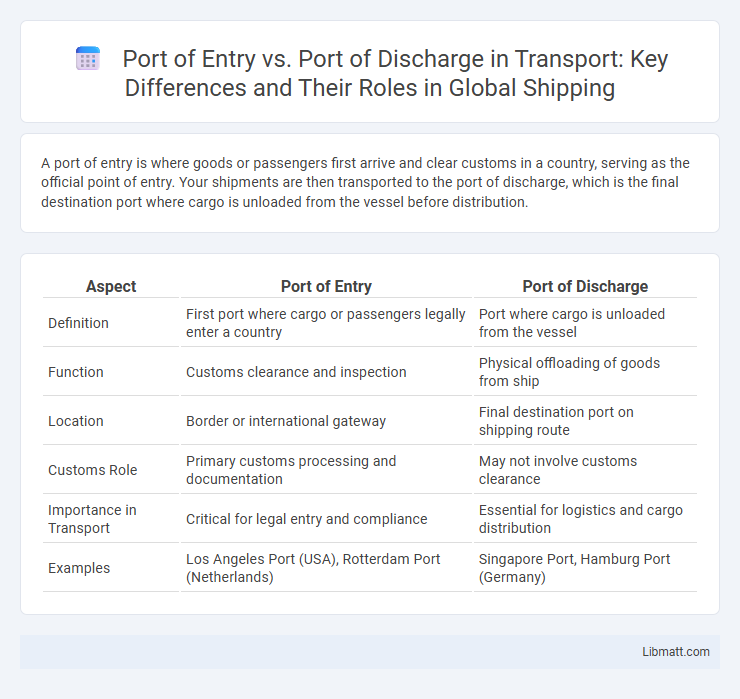A port of entry is where goods or passengers first arrive and clear customs in a country, serving as the official point of entry. Your shipments are then transported to the port of discharge, which is the final destination port where cargo is unloaded from the vessel before distribution.
Table of Comparison
| Aspect | Port of Entry | Port of Discharge |
|---|---|---|
| Definition | First port where cargo or passengers legally enter a country | Port where cargo is unloaded from the vessel |
| Function | Customs clearance and inspection | Physical offloading of goods from ship |
| Location | Border or international gateway | Final destination port on shipping route |
| Customs Role | Primary customs processing and documentation | May not involve customs clearance |
| Importance in Transport | Critical for legal entry and compliance | Essential for logistics and cargo distribution |
| Examples | Los Angeles Port (USA), Rotterdam Port (Netherlands) | Singapore Port, Hamburg Port (Germany) |
Introduction to Port of Entry and Port of Discharge
Port of entry refers to the first location where goods or passengers legally enter a country and undergo customs clearance, ensuring compliance with import regulations. Port of discharge is the final destination port where cargo is unloaded from a vessel, marking the completion of its maritime transport before inland distribution. Understanding distinctions between these ports is crucial for logistics and supply chain management to optimize customs procedures and cargo handling.
Defining Port of Entry in Global Trade
Port of entry in global trade refers to the designated location where goods and cargo first arrive and undergo customs clearance upon entering a country. It serves as the official checkpoint for inspections, documentation processing, and compliance with import regulations, ensuring legal admission into the domestic market. Unlike the port of discharge, which is the final destination where cargo is unloaded, the port of entry is critical for initiating customs procedures and controlling cross-border trade flows.
Understanding Port of Discharge in Shipping
Port of discharge refers to the specific location where your cargo is unloaded from the vessel at the destination, marking the end point of the sea leg in shipping logistics. Unlike the port of entry, which can denote the location where goods enter a country and undergo customs clearance, the port of discharge is solely concerned with offloading the shipment for further inland transportation. Understanding the distinction between these ports is crucial for accurate freight documentation, customs compliance, and efficient supply chain management.
Key Differences Between Port of Entry and Port of Discharge
The port of entry is the first location where goods or passengers arrive in a country and undergo customs clearance, while the port of discharge is where cargo is unloaded from the vessel before reaching its final destination. The port of entry involves immigration and customs inspections, ensuring compliance with national regulations, whereas the port of discharge primarily focuses on offloading the shipment for subsequent inland transportation. Understanding these distinctions is crucial for logistics planning, shipping documentation, and international trade compliance.
Role in Customs Clearance and Documentation
A port of entry serves as the official location where your goods first arrive in a country and undergo customs clearance, including inspection and regulatory compliance checks. The port of entry is responsible for processing import documentation such as customs declarations, invoices, and certificates of origin to ensure goods meet legal requirements. In contrast, the port of discharge primarily functions as the location where cargo is unloaded from the vessel, with limited customs activities unless it also serves as the designated port of entry.
Impact on Shipping Logistics and Costs
The port of entry affects customs clearance, import regulations, and initial handling fees, directly influencing shipping timelines and administrative expenses. In contrast, the port of discharge determines final cargo delivery, storage charges, and inland transportation costs, impacting overall delivery efficiency and total logistics expenditure. Efficient coordination between these ports optimizes supply chain flow, reducing delays and minimizing freight costs.
Importance in Import and Export Procedures
Ports of entry and ports of discharge are crucial in import and export procedures, as the port of entry serves as the official location where goods enter a country, undergoing customs inspections and documentation verification. The port of discharge is the destination port where cargo is unloaded from the vessel, impacting logistics, storage, and distribution planning. Efficient coordination between these ports ensures compliance with international trade regulations, reduces delays, and minimizes costs in global supply chain management.
Common Challenges at Ports of Entry and Discharge
Common challenges at ports of entry and ports of discharge include congestion due to limited infrastructure capacity and lengthy customs clearance procedures. Delays often arise from inadequate coordination between authorities, leading to increased demurrage costs and disrupted supply chains. Your shipments are at risk of delayed delivery when documentation errors or compliance issues occur at these critical logistic points.
Choosing the Right Port for Your Cargo
Selecting the appropriate port of entry or port of discharge significantly impacts shipping efficiency and costs. The port of entry is where goods first arrive in a country and undergo customs clearance, while the port of discharge is the final location where cargo is unloaded for delivery. Evaluating factors such as proximity to the destination, port infrastructure, customs processes, and logistical support ensures optimal handling and timely distribution of your cargo.
Frequently Asked Questions: Port of Entry vs Port of Discharge
The port of entry is where goods or passengers first arrive in a country and undergo customs clearance, while the port of discharge is the final destination where cargo is unloaded from a vessel. Frequently asked questions often address the difference in customs procedures, responsibilities of importers, and how these ports affect shipping documentation and delivery timelines. Understanding distinctions between port of entry and port of discharge is crucial for accurate logistics planning and compliance with international trade regulations.
port of entry vs port of discharge Infographic

 libmatt.com
libmatt.com